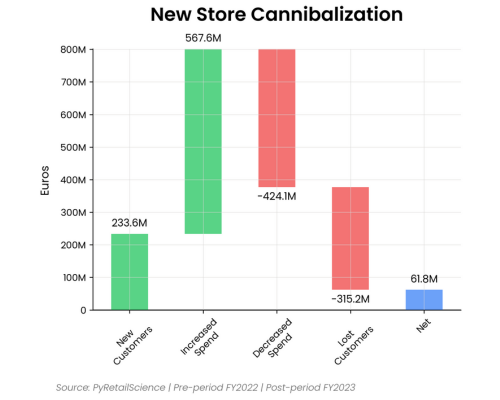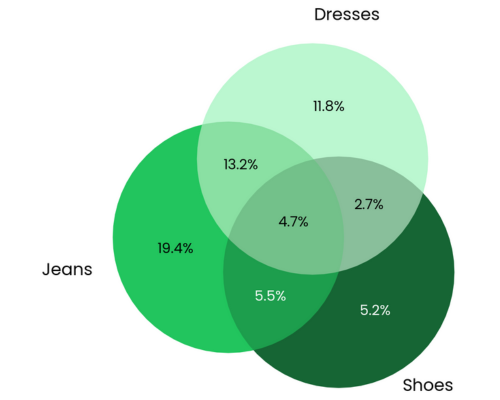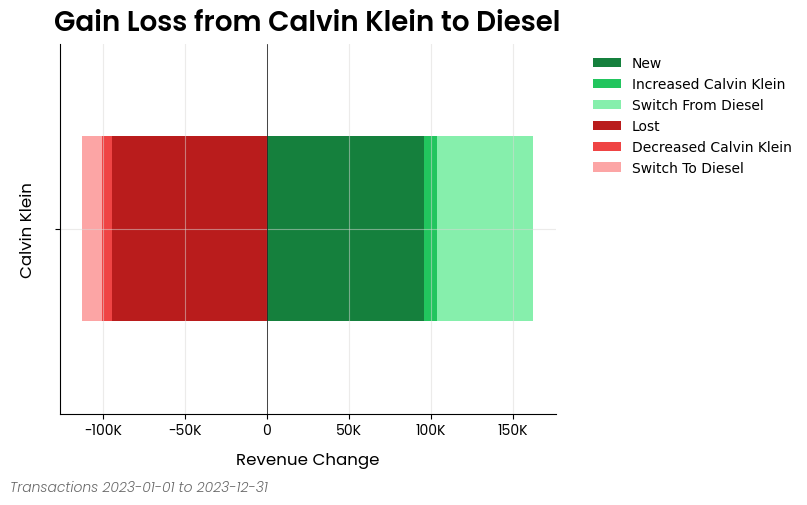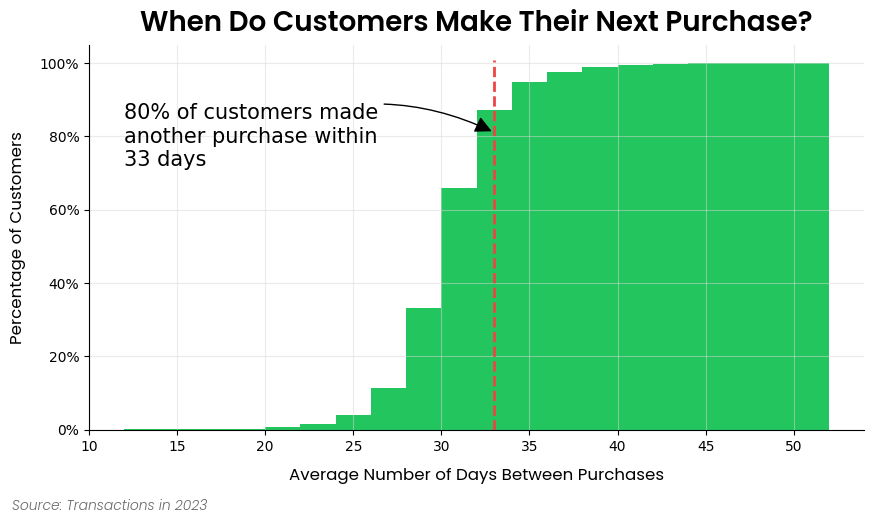⚡ Rapid bespoke and deep dive retail analytics ⚡
PyRetailScience equips you with a wide array of retail analytical capabilities, from segmentations to gain-loss analysis. Leave the mundane to us and elevate your role from data janitor to insights virtuoso.
To get the latest release:
pip install pyretailscienceAlternatively, if you want the very latest version of the package you can install it from GitHub:
pip install git+https://github.com/Data-Simply/pyretailscience.git- Tailored for Retail: Leverage pre-built functions designed specifically for retail analytics. From customer segmentations to gains loss analysis, PyRetailScience provides over a dozen building blocks you need to tackle retail-specific challenges efficiently and effectively.
-
Reliable Results: Built with extensive unit testing and best practices, PyRetailScience ensures the accuracy and reliability of your analyses. Confidently present your findings, knowing they're backed by a robust, well-tested framework.
-
Professional Charts: Say goodbye to hours of tweaking chart styles. PyRetailScience delivers beautifully standardized visualizations that are presentation-ready with just a few lines of code. Impress stakeholders and save time with our pre-built, customizable chart templates.
- Workflow Automation: PyRetailScience streamlines your workflow by automating common retail analytics tasks. Easily loop analyses over different dimensions like product categories or countries, and seamlessly use the output of one analysis as input for another. Spend less time on data manipulation and more on generating valuable insights.
Here is an excerpt from the gain loss analysis example notebook
from pyretailscience.analysis.gain_loss import GainLoss
gl = GainLoss(
df,
# Flag the rows of period 1
p1_index=time_period_1,
# Flag the rows of period 2
p2_index=time_period_2,
# Flag which rows are part of the focus group.
# Namely, which rows are Calvin Klein sales
focus_group_index=df["brand_name"] == "Calvin Klein",
focus_group_name="Calvin Klein",
# Flag which rows are part of the comparison group.
# Namely, which rows are Diesel sales
comparison_group_index=df["brand_name"] == "Diesel",
comparison_group_name="Diesel",
# Finally we specifiy that we want to calculate
# the gain/loss in total revenue
value_col="total_price",
)
# Ok now let's plot the result
gl.plot(
x_label="Revenue Change",
source_text="Transactions 2023-01-01 to 2023-12-31",
move_legend_outside=True,
)
plt.show()Here is an excerpt from the cross shop analysis example notebook
from pyretailscience.analysis import cross_shop
cs = cross_shop.CrossShop(
df,
group_1_col="category_name",
group_1_val="Jeans",
group_2_col="category_name",
group_2_val="Shoes",
group_3_col="category_name",
group_3_val="Dresses",
labels=["Jeans", "Shoes", "Dresses"],
)
cs.plot(
title="Jeans are a popular cross-shopping category with dresses",
source_text="Source: Transactions 2023-01-01 to 2023-12-31",
figsize=(6, 6),
)
plt.show()
# Let's see which customers were in which groups
display(cs.cross_shop_df.head())
# And the totals for all groups
display(cs.cross_shop_table_df)Here is an excerpt from the customer retention analysis example notebook
ax = dbp.plot(
figsize=(10, 5),
bins=20,
cumulative=True,
draw_percentile_line=True,
percentile_line=0.8,
source_text="Source: Transactions in 2023",
title="When Do Customers Make Their Next Purchase?",
)
# Let's dress up the chart a bit of text and get rid of the legend
churn_period = dbp.purchases_percentile(0.8)
ax.annotate(
f"80% of customers made\nanother purchase within\n{round(churn_period)} days",
xy=(churn_period, 0.81),
xytext=(dbp.purchase_dist_s.min(), 0.8),
fontsize=15,
ha="left",
va="center",
arrowprops=dict(facecolor="black", arrowstyle="-|>", connectionstyle="arc3,rad=-0.25", mutation_scale=25),
)
ax.legend().set_visible(False)
plt.show()Please see here for full documentation, which includes:
- Analysis Modules: Overview of the framework and the structure of the docs.
- Examples: If you're looking to build something specific or are more of a hands-on learner, check out our examples. This is the best place to get started.
- API Reference: Thorough documentation of every class and method.
We welcome contributions from the community to enhance and improve PyRetailScience. To contribute, please follow these steps:
- Fork the repository.
- Create a new branch for your feature or bug fix.
- Make your changes and commit them with clear messages.
- Push your changes to your fork.
- Open a pull request to the main repository's
mainbranch.
Please make sure to follow the existing coding style and provide unit tests for new features.
This repository is supported by Data simply.
If you are interested in seeing what Data Simply can do for you, then please email email us. We work with companies at a variety of scales and with varying levels of data and retail analytics sophistication, to help them build, scale or streamline their analysis capabilities.

Made with contrib.rocks.
Built with expertise doing analytics and data science for scale-ups to multi-nationals, including:
- Loblaws
- Dominos
- Sainbury's
- IKI
- Migros
- Sephora
- Nectar
- Metro
- Coles
- GANNI
- Mindful Chef
- Auchan
- Attraction Tickets Direct
- Roman Originals
This project is licensed under the Elastic License 2.0 - see the LICENSE file for details.
This directory contains integration tests that verify all PyRetailScience analysis modules work correctly with Google BigQuery as a backend. These tests confirm that the Ibis-based code paths function correctly when connected to BigQuery.
The integration tests cover the analysis modules.
To run these tests, you need:
- Access to a Google Cloud Platform account
- A service account with BigQuery permissions
- The service account key JSON file
- The test dataset must be loaded in BigQuery (dataset:
test_data, table:transactions)
- Set up authentication:
export GOOGLE_APPLICATION_CREDENTIALS=/path/to/your/service-account-key.json
export GCP_PROJECT_ID=your-project-id- Install dependencies:
uv sync- Run the tests:
# Run all tests
uv run pytest tests/integration/bigquery -v
# Run specific test module
uv run pytest tests/integration/bigquery/test_cohort_analysis.py -vThese tests can be run manually in GitHub Actions via the "BigQuery Integration Tests" workflow. To run:
- Go to the "Actions" tab in the GitHub repository
- Select the "BigQuery Integration Tests" workflow
- Click "Run workflow"
- Optionally enter a test filter pattern (e.g., "test_cohort_analysis")
- Click "Run workflow"
To run the workflow in GitHub Actions, add these secrets to your repository:
GCP_SA_KEY: The entire JSON content of your GCP service account key fileGCP_PROJECT_ID: Your GCP project ID




